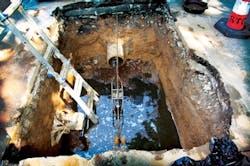About the author: Cole Mitcham, P.E., is senior project manager for Kentucky American Water. Mitcham can be reached at 859.335.3415.
Our daily lives, communities and economy depend on functioning infrastructure. All across America, communities are faced with the massive challenge of replacing critical water and wastewater infrastructure. Water utilities’ need of private funds for financing upgrades to pipes, pumps and plants is increasingly dire. Too often, it is not until these critical arteries rupture that we pay attention.
Such emergencies are becoming more common. The American Society of Civil Engineers most recently gave America a “D” rating in terms of infrastructure, citing dilapidated roadways, insufficient waterways and “a pressing need for modernization.” The group estimates $3.6 trillion would need to be invested into U.S. infrastructure by 2020 just to raise the country’s support systems to acceptable levels.
Old Pipes, New Technology
Kentucky American Water is an investor-owned utility based in Lexington, Ky., that provides drinking water service to approximately half a million people in portions of 11 counties. The company also provides wastewater services to approximately 1,000 customers in portions of three counties.
The company continuously monitors, maintains and upgrades its facilities to ensure they operate efficiently and meet all regulatory standards. This requires investing in its water system, including treatment plants, distribution system pipes, tanks, pump stations, fire hydrants and metering equipment. The company invests approximately $20 million annually into its operating systems.
The water mains in downtown Lexington, Ky., were installed in the early 1900s and had surpassed their useful life. Instead of resorting to the traditional “dig and replace” method used in the past, Kentucky American Water explored different replacement technologies as an alternative for this commercial and residential area.
The $230,000-project involved replacing 1,200 ft of 10-in.-diameter and 12-in.-diameter cast iron pipe.
Breaking the Mold
Typically, water main replacements involve significant excavation—digging through pavement and concrete. This can be disruptive for traffic and extend the time needed for restoration after the pipe replacement is complete.
With a focus on minimizing disruption for customers, the company piloted a new technology for potable water called Aqua-Pipe Resin Impregnated Liner Pipe, also known as trenchless technology. It restores existing water main without full-length excavation and trenching, is less disruptive and more cost-effective.
Trenchless technology involves digging access pits, cleaning the existing pipe, and slip lining an existing pipe with a new pipe made of cured-in-place pipe. This technology has been widely used in rehabilitating gravity sanitary sewer lines, but is new for water mains. This project also marked the first time Kentucky American Water used trenchless technology for a waterline replacement.
Trenchless Installation
Following the excavation of the access pits, a temporary bypass was installed using above ground manifold with connections to meter pits or house hose bibs. The pipe was then cut open at the access pits and cleaned to prepare for lining.
After the cleaning process, a full video inspection was performed using closed-circuit television (CCTV) to map the service connections. As a final preparation for installing the liner, plugs were inserted into every service connection from inside the pipe using specialized robotic equipment.
The epoxy was then injected into the liner onsite and pulled the liner into place. By sending swabs from one end to the other, the liner was formed and pressurized with hot water. This water pushed the epoxy into any void or crack along the host main while also curing it. The crew then performed a hydrostatic pressure test to ensure the liner had cured properly.
Following this, each service was to be robotically reinstated. To do so, an operator inside of a camera truck used a robotic drill to drill through the liner and into the service, fully removing the plug that was previously placed inside of it.
Lastly, the new line was disinfected and the water distribution systems were reconnected.
Service Resumes
Although there were a few setbacks, it took about one month to line approximately 325 ft of 12-in. water main and 964 ft of 10-in. water main. This included setting up the temporary water to reconnect the water mains and services to the new lined water main.
Kentucky American Water was able to deliver a service to its customers that was cost-effective but also minimized the disruption in the service area. By investing in this trenchless technology, the company can ensure reliable service for customers in Lexington.
